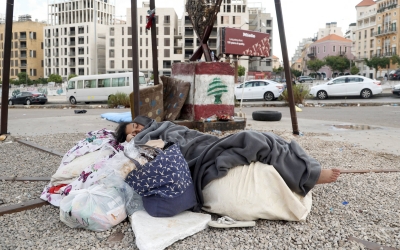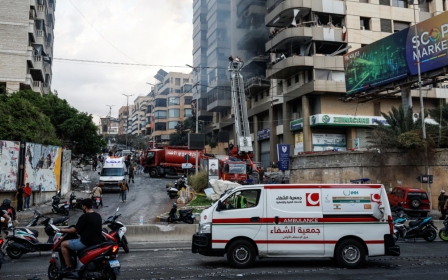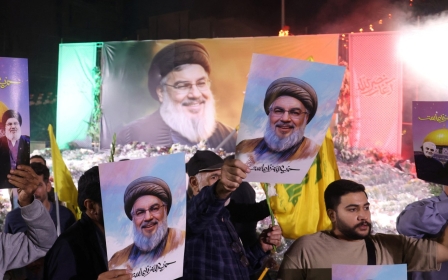Beirut’s Dahiyeh left deserted and destroyed after brutal Israeli bombardment

The streets of the once-bustling Haret Hreik neighbourhood in southern Beirut were empty. Debris buried the wheels of a vegetable cart abandoned on the curb. Rows of shops stood shuttered, their entrances littered with shards of glass.
A man sped by on his motorcycle, laden with bags. Like many before him, he was likely fleeing his home, caught under fire.
Since 23 September, Israel has significantly escalated its attacks on what it says are Hezbollah targets throughout Lebanon. But residential buildings, civilian infrastructure, ambulances and civil defence personnel have also been hit.
The southern suburbs, commonly known as Dahiyeh, have borne the brunt of the Israeli bombardments in Beirut. Israel has targeted multiple senior Hezbollah members who live in the densely packed neighbourhood, destroying civilian infrastructure, homes and shops, and killing hundreds of people.
Middle East Eye visited Haret Hreik on a press tour organised by Hezbollah on Wednesday after consecutive days of Israeli attacks had reduced large parts of the residential area to rubble.
New MEE newsletter: Jerusalem Dispatch
Sign up to get the latest insights and analysis on Israel-Palestine, alongside Turkey Unpacked and other MEE newsletters
Overnight on Thursday, another powerful blast was heard throughout Beirut, reportedly one of the most violent strikes on Dahiyeh, even more intense than the one that killed Hezbollah leader Hassan Nasrallah. Israeli officials said they targeted Hashem Safieddine, a potential successor to Nasrallah. The Lebanese group has yet to comment on the target of the overnight strike.
The Israeli military says its attacks are aimed at Hezbollah, “but the impact on ordinary people and civilians has been catastrophic”, warned Human Rights Watch (HRW) researcher Ramzi Kaiss on social media.
He condemned Israel’s apparent “war crimes” in Lebanon, including the “apparently unlawful attacks on civilians, journalists, aid workers and children”.
Targeting the press
Hussein Mortada, a political analyst and journalist with the Lebanese Islamic media channel al-Sirat TV, pulled a camera from a pile of rubble that was once his office at the TV station’s headquarters.
“Israel targeted this camera and the press,” he told reporters at the scene. “If I had been in that building, then I wouldn’t be standing here in front of you.”
Mortada described al-Sirat TV as a “religious, non-political channel”, though it is known to support Hezbollah, one of Lebanon’s most powerful political parties. Most television channels and newspapers in Lebanon side with a certain party, so al-Sirat is not an anomaly.
Hezbollah has denied Israel’s claims that weapons were present in civilian buildings, including the al-Sirat headquarters.
“They [Israeli forces] target civilian areas,” Mortada said. “This is a densely populated area. Until now, the number of those dead and injured is not clear because there are still people stuck under the rubble,” he added.
On Thursday, Lebanon’s health minister said that a total of 1,974 people have been killed, including 127 children, and over 9,000 wounded since Hezbollah and Israel began fighting on 8 October last year.
Near the demolished press office, the glass doors of a beauty salon were completely shattered, revealing its pink and floral decor inside. Purple flowers from the salon lay at the entrance, buried under shards of glass and large chunks of debris.
Despite the danger, Mortada, also a resident of the neighbourhood, said he would remain in his home.
"We have lived here and we know every street and corner. They will never make us leave," he said.
Attacks on healthcare
Hassan Ammar, 82, gazed up at his apartment building in central Beirut’s Bashoura neighbourhood. An entire floor was wiped out in an Israeli strike overnight on Wednesday.
“It was 12.20 at night (9.20pm GMT),” he recalled, when what sounded like three large explosions jolted his family awake. “We rushed outside and we saw the injuries and destruction,” he told Middle East Eye.
The Israeli strike targeted the Hezbollah-affiliated Islamic Health Committee (IHC) office, killing seven rescue workers, two of whom were volunteers. Lebanon’s health ministry said that a total of nine people were killed and 14 wounded.
A fire broke out in the building after the strike and residents reported a sulphur-like smell. Lebanon’s state-run National News Agency (NNA) accused Israel of using the internationally banned phosphorus bombs.
'This is a densely populated area. Until now, the number of those dead and injured is not clear because there are still people stuck under the rubble'
- Hassan Mortada, journalist
It was the second strike in central Beirut in just a matter of days, marking an expansion of attacks on the capital beyond the southern suburbs. On Sunday night, 29 September, Israel targeted members of the leftist Palestine resistance group, the Popular Front for the Liberation of Palestine (PFLP), in Beirut’s busy transit centre, known as Cola.
Commenting on Wednesday night's strike on his building, Ammar said: “[They] are attacking a health authority that helps civilians… in the absence of a Lebanese government who cannot fully serve the people.”
Hezbollah operates an extensive network of social services, including infrastructure, healthcare facilities, schools and youth programmes. These services are vital for many people in the country, especially as the Lebanese government’s ability to provide basic public services has deteriorated over four years of economic crisis.
On Thursday evening, the World Health Organization (WHO) announced that 28 healthcare workers were killed in just 24 hours while on duty. An Israeli strike on a Lebanese Red Cross convoy in southern Lebanon on Thursday wounded four of its medics deployed to carry out a “humanitarian mission”.
“Without these organisations, what will the civilians do?” Ammar asked.
Across the street from Ammar’s apartment building, visitors wander through a graveyard, where several gravestones were destroyed by the force of Israel’s blast.
'Dahiyeh Doctrine'
For six consecutive nights, Azhar Terekman, 28, had been sleeping on the pavement in downtown Beirut’s Martyrs' Square when Middle East Eye spoke to her on Thursday. She is one of over a million people now estimated to be displaced in Lebanon, according to Prime Minister Najib Mikati.

Like many others, she fled to the area on the night of 27 September, after Israel dropped dozens of 900kg bunker-busting bombs near her home in Dahiyeh and killed Nasrallah. She explained that she could not afford rent elsewhere, and shelters were either full or located in areas she felt were dangerous.
“Our house started shaking as if the bomb was next to us, so we immediately left everything, including our money, and fled,” Terekman recounted. “Our house was nearly destroyed.”
The US-made bunker-busting bombs have a destruction radius of 35m. The Friday attack flattened six residential buildings and created a massive crater in the neighbourhood.
Analysts have noted a repeat of Israel’s “Dahiyeh Doctrine”, a military strategy that advocates the massive and disproportionate use of force and the deliberate targeting of civilians and civilian infrastructure, in Gaza and now in Lebanon, according to the Lebanese English daily L’Orient Today.
The doctrine emerged during the 2006 war between Israel and Hezbollah, when Israel killed 1,200 people, displaced 900,000 and destroyed or severely damaged much of Lebanon’s civilian infrastructure, including airports, water reserves, sewage treatment plants, power stations, fuel stations, schools, health centres and hospitals, according to the Red Cross.
In 2008, Israeli army chief Gadi Eizenkot told Reuters that Israel would use “disproportionate” force to destroy Lebanese villages from which Hezbollah launched attacks on its cities in any future conflict. “From our standpoint, these are not civilian villages; they are military bases,” Eizenkot said.
'Our house started shaking as if the bomb was next to us, so we immediately left everything, including our money, and fled'
- Azhar Terekman, displaced Lebanese
Analysts and rights activists have expressed alarm over Israel’s “human shield” discourse and its role in justifying attacks on civilians and civilian infrastructure.
While the Israeli army has called on civilians to leave their homes prior to certain attacks, these warnings are often issued just an hour in advance and often at night when many are asleep.
“There is no safety since the attacks are all around us,” Terekman said, as Israeli drones buzzed above her makeshift bed in Martyrs' Square.
‘Unbelievable levels of violence’
On the outskirts of the Haret Hreik neighbourhood in south Beirut, a massive pile of rubble is still smoking from an Israeli attack early Wednesday morning.
“We are witnessing unbelievable levels of violence,” Ghassan Jouneh, a resident of the area, told Middle East Eye near the demolished apartment complex.
“Every Israeli strike that is hitting us is destroying six to seven buildings,” he said.
Despite the destruction, Jouneh insisted that Israel’s violence would not crush resistance groups like Hezbollah. “The resistance groups are too huge to be ended like this,” he said.
“The Israelis can try from now and for the next 100 years and they will still not manage to succeed.”
Three men climbed atop the smoking rubble and raised their fists into the air. In front of the crowd of journalists below, they chanted in unison for Nasrallah and for the defeat of America and Israel.
Middle East Eye delivers independent and unrivalled coverage and analysis of the Middle East, North Africa and beyond. To learn more about republishing this content and the associated fees, please fill out this form. More about MEE can be found here.





